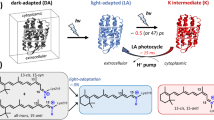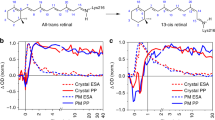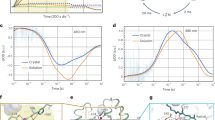Abstract
THE sole protein found in the purple membrane of Halobacterium halobium contains retinal covalently bound by means of a protonated Schiff base linkage to lysine1,2. The only established function of this protein is to act as a light-driven proton pump producing a transmembrane proton gradient, which is coupled to ATP synthesis in the living organism2,3. In so far as the retinal prostheticgr oup resembles that found in the visual pigment of vertebrates, rhodopsin, the name bacteriorhodopsin has been widely adopted for this protein3. Considerable work has been done on the biochemistry and photochemistry of the purple membrane, both for its intrinsic interest as a unique photosynthetic membrane and with respect to the identification of possible mechanistic relationships between its photochemical cycle and that of the visual process. We report here a study of the later stages of the photochemical cycle by flash photometry with plane polarised light. Our results indicate conformational change in the bacteriorhodopsin molecule at the site of the visible chromophore.
This is a preview of subscription content, access via your institution
Access options
Subscribe to this journal
Receive 51 print issues and online access
$199.00 per year
only $3.90 per issue
Buy this article
- Purchase on Springer Link
- Instant access to full article PDF
Prices may be subject to local taxes which are calculated during checkout
Similar content being viewed by others
References
Oesterhelt, D., and Stoeckenius, W., Nature new Biol., 233, 149–152 (1971).
Oesterhelt, D., and Stoeckenius, W., Proc. natn. Acad. Sci. U.S.A., 70, 2850–2857 (1973).
Oesterhelt, D., Angew. Chem. (Int. Ed.), 15, 17–24 (1976).
Cone, R. A., Nature new Biol., 236, 39–43 (1972).
Brown, P. K., Nature new Biol., 236, 35–38 (1972).
Ebrey, T. G., and Honig, B., Q. Rev. Biophys., 8, 129–184 (1975).
Henderson, R., and Unwin, P. N. T., Nature, 257, 28–32 (1975).
Razi-Naqvi, K., Gonzalez-Rodriguez, J., Cherry, R. J., and Chapman, D., Nature new Biol., 245, 249–251 (1973).
Sherman, W. V., Slifkin, M. A., and Caplan, S. R., Biochim. biophys. Acta, 423, 238–248 (1976).
Sherman, W. V., and Caplan, S. R., Nature, 258, 766–768 (1975).
Lewis, A., Spoonhower, J., Bogomolni, R. A., Lozier, R. H., and Stoeckenius, W., Proc. natn. Acad. Sci. U.S.A., 71, 4462–4466 (1974).
Sherman, W. V., Korenstein, R., and Caplan, S. R., Biochim. biophys. Acta, 430, 454–458 (1976)
Albrecht, A. C., Prog. Reaction Kinetics, 5, 302–334 (1970).
Jablonski, A., Z. Naturforsch., 16a, 1–4 (1961).
Moelwyn-Hughes, E. A., Chemical Statics and Kinetics in Solution, Ch. 5 (Academic, London, 1971).
Edsall, J. T., in Proteins, Amino Acids and Peptides (edit. by Cohn, E. J., and Edsall, J. T.), 506–542 (Reinhold, New York, 1943).
Author information
Authors and Affiliations
Rights and permissions
About this article
Cite this article
SHERMAN, W., CAPLAN, S. Chromophore mobility in bacteriorhodopsin. Nature 265, 273–274 (1977). https://doi.org/10.1038/265273a0
Received:
Accepted:
Issue Date:
DOI: https://doi.org/10.1038/265273a0
This article is cited by
-
Structure of the intermediate species of the photoreaction cycle of bacteriorhodopsin
Proceedings / Indian Academy of Sciences (1981)
Comments
By submitting a comment you agree to abide by our Terms and Community Guidelines. If you find something abusive or that does not comply with our terms or guidelines please flag it as inappropriate.



